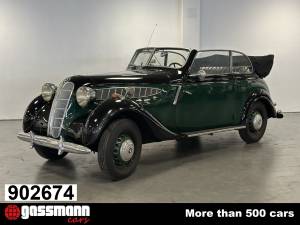BMW 321 Classic Cars for Sale
The BMW 321 stands as a distinct chapter in Germany’s automotive past, uniting ambitious engineering with a unique pre- and post-war production legacy. Available as a refined two-door saloon or an elegant cabriolet, the 321 incorporates a six-cylinder engine, nuanced handling, and the robust steel bodywork of Ambi-Budd. Its scarcity makes it a rare opportunity for enthusiasts to explore a pivotal era in BMW’s evolution.
Search results

1939 | BMW 321
321 2.0L Cabriolet
History of the BMW 321
The BMW 321 was introduced in late 1938 as a response to the need for an agile, compact vehicle that could draw from the technical progression of BMW’s established pre-war lineup. Initially manufactured at the celebrated Eisenach plant, the 321’s early production was abruptly halted in 1941 as the war effort redirected resources to aircraft engines. Notably, only 3,814 cars left the factory before the pause. Production resumed post-1945 under Soviet occupation, with tools and blueprints seized at Eisenach. The car remained in legacy production until 1950, now under Soviet administration, producing an additional 8,996 vehicles. This tumultuous history is embedded in every surviving BMW 321.
Model History and Evolution
As the direct successor to the BMW 320, the 321 improved upon chassis dynamics and aesthetics by adapting the BMW 326’s sophisticated suspension while minimising external dimensions. Its primary bodywork options—saloon and cabriolet—reflected both practicality and style. Buyers could also order a bare chassis for custom coachwork, a notable practice among interwar and immediate postwar European manufacturers. The BMW 321 was eventually succeeded in Eastern Europe by the EMW 340 and, for Western markets, the all-new BMW 501. Its production closed the chapter of pre-war BMW saloons and paved the way for the brand’s post-war revival.
Highlights and Unique Features
The BMW 321 was engineered as an agile, robust six-cylinder car making judicious use of existing BMW architecture, with an advanced steel body from Ambi-Budd and double Solex carburettors. Rear-hinged doors and revised bumpers added distinctive, practical touches. Furthermore, the option for naked chassis purchase enabled tailored, bespoke vehicles uncommon in this class. Its robust mechanicals and straightforward design make it a gateway for enthusiasts into the realm of pre-war classics.
Technical Data of the BMW 321
Special Editions and Collectible Models
During its production, the BMW 321 was offered in two key versions: the standard saloon and the cabriolet. While no officially badged special editions are documented, the chassis-only option allowed coachbuilders and private customers to create distinctive, custom-bodied 321s. Such bespoke examples are sought after in collector circles for their uniqueness and craftsmanship, and their history often enhances provenance within classic car gatherings.
Engine, Driving Dynamics, and Handling
Equipped with a robust six-cylinder engine and a well-balanced chassis derived from the more executive BMW 326, the 321 delivers a composed yet accessible driving experience. The engine’s power delivery is smooth and sufficient for period expectations, reaching up to 115 km/h. Handling is agile thanks to its modest weight, comparatively shorter chassis, and thoughtfully upgraded suspension. The four-speed manual gearbox, coupled with rear-wheel drive, provides direct engagement—a characteristic appreciated by enthusiasts exploring pre-war driving dynamics. - BMW 321 Typ 321: The most prevalent variant, representing over 70% of the market supply and more than 83% of buyer interest among 321-series classics.
- BMW 321 Typ 321/2: Represents 30% of supply, with a more limited following compared to the original 321, but valued for its subtle evolutions and scarcity.
Interior, Comfort, Exterior, and Design
Ambi-Budd’s steel bodywork provides the 321 with marked rigidity and lasting durability. Door hinges positioned at the rear—a feature known as 'suicide doors'—offered practical ingress, while bumper modifications and the flowing saloon silhouette provided a recognisable look distinct from its predecessor, the 320. In the cabriolet, open-top motoring combined with subtle luxury details and solid mechanical underpinnings. Interiors were functional but boasted period-appropriate trim and accessible comfort, reflective of pre-war middle-class expectations. Custom orders and coach-built versions allowed for further individualisation with fine upholstery and unique paint hues, characteristics valued by today’s collectors.
Other Notable Features
BMW’s willingness to deliver the 321 as a bare chassis for external coachbuilding demonstrates the flexibility and ambition of the brand during uncertain times. Collaboration with Ambi-Budd, whose Berlin facility produced advanced all-steel bodies, was a significant industrial partnership and contributed to the car’s structural integrity. Many 321 models remained in Eastern Europe post-war, and their survival often reflects challenging restoration histories due to part scarcity from their limited production and geographic concentration.
Summary
The BMW 321 is a specialised chapter in BMW’s lineage, bridging the pre- and post-World War II eras with a balance of mechanical solidity, adaptable coachwork, and strong enthusiast interest, as reflected in current supply and demand shares. Its advanced engineering, sourcing from Ambi-Budd for steel fabrication, and the option for custom coachwork make it an engaging proposition for collectors focused on automotive innovation during moments of intense historical change.
